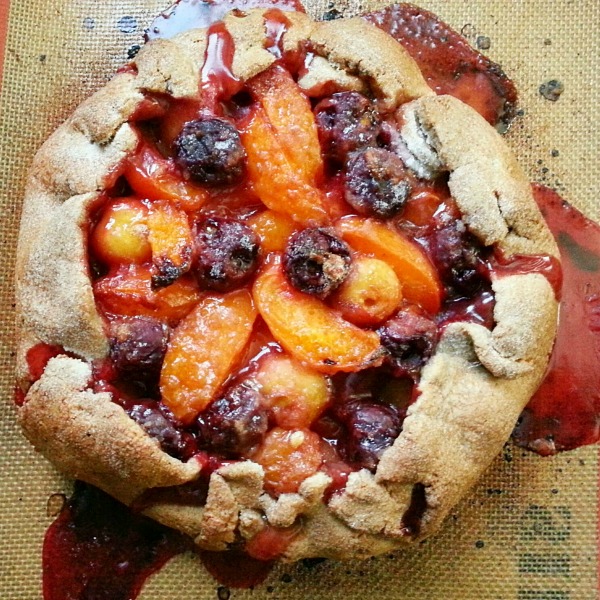In the dog days of summer, sometimes you just want a quick dessert like a galette to showcase the fabulous flavours of summer stonefruits like apricots, cherries and peaches. And with such naturally juicy bounty, you need something a little more robust than a typical shortcrust to soak up those juices – this buckwheat galette hits the mark.
I am in love right now with buckwheat, and have been using a couple of different buckwheat flours, including one readily available at one of our supermarkets, milled by Cuisine de Soleil. It’s great for adding nutritional value to the flour blends I create for things like muffins, but also adds some binding and moisture-retaining properties to baked goods, and it adds a flavour dimension that the more typical starch-heavy pastry recipes lack. The final recipe uses a combination of buckwheat, sorghum, sweet rice and cornstarch for a great tasting and a reasonably well-behaved gluten-free pastry.
I’ve made this version with butter – a classic pate brisee, but you could just as easily substitute a solid vegan shortening such as Earth Balance in order to make it dairy-free. This is something that could be done in a food processor, but making by hand and taking the time to work the pastry by hand (fraisage) really creates a superior texture.
Technique
The technique here is exactly the same as you would employ with a wheat-based pastry. All of the dry ingredients are combined together and whisked well. Then the butter or shortening is cut into the mixture until it becomes crumbly with the largest pieces about the size of a pea. I use a metal pastry cutter to do this, and it takes about 3-5 minutes to achieve this texture. You could use a food processor, but you will end up with a finer mixture – those larger chunks of butter are THE thing that is going to make your pastry flakier.
Once you have cut the butter in with the pastry cutter, gradually add the liquid, cutting it in with a knife. It will still look like a crumbly mess, but will just hold together if you squeeze a handful together. Dump the whole mess out onto a clean, smooth countertop or large silpat mat. Here’s where its gets all fraisage-ey! You are going to heap the pile together gently with a bench scraper, and then with the heel of your hand, push down and away from you – you want to shear those pieces of butter into the pastry so they become thin sheets. Keep using the bench scraper to bring the pile together, and work the pastry in the same direction away from you until it starts to hold together in a ball.
Once you have the dough together in a ball, wrap it well in plastic wrap or in an airtight ziploc bag, and let it chill in the fridge for at least 1 hour, preferably overnight. This does a couple of things:
- it allows the flours to fully hydrate which will make your end product less crumbly. Gluten-free whole “grain” flours (the buckwheat and sorghum) absorb proportionally more moisture than refined wheat flour, and do so more slowly. In order to get a texture that is not crumbly and dry after baking, these flours need to be fully hydrated.
- a rest in the fridge allows the thin shears of butter to solidify again, meaning when the pastry is rolled out and baked, the butter layers can go from solid to liquid+steam much more quickly – it is that expansion of steam that makes for the flakiness.
- because the pastry can be made in advance (and frozen for 1-2 months even), it means you can prepare a lot of pastry ahead of time if you are so inclined, and have in in reserve. Just defrost it in the fridge if you do this.
Why did I use these flours?
As I mentioned earlier, I’m on a buckwheat kick, because I love the flavour it imparts and the structure it contributes to baked goods, especially when used in conjunction with other flours. It also adds a more rustic visual touch to the pastry, which I think is a nice foil for a more country-style dessert such as this galette. It also adds nutritional value to the pastry, being chock full of protein, vitamins and minerals.
This flour combination also uses sorghum in roughly equal proportions to the buckwheat. Sorghum is mild tasting, but most importantly for this pastry recipe, has a great binding quality which is great in pastry and cookies. Another option would be amaranth flour, but it is quite strong tasting and would overwhelm the buckwheat. I tried this with all buckwheat, but preferred the texture with sorghum, and I also tried using millet which gave great taste and texture, but was much harder to work with, so would be more suitable as a press-in crust for a tart.
Sweet rice flour (also called glutinous rice flour – but has NO gluten) is a great gluten-free pantry staple. It is the same flour used to make mochi – the Japanese rice cakes. Because it is naturally sticky, it enables you to lighten the pastry without relying as heavily on starches, and IMO gives a better, less gummy texture than a starch-heavy pastry recipe. This also has the benefit of giving you binding while being able to cut down the amount of xanthan gum used.
Finally I’ve used a small amount of cornstarch, which in conjunction with the tablespoon of sugar, will help promote a browner crust. Many of the gluten-free flours don’t brown as readily as wheat flours, and need a little help.
Forming the galette
A single recipe will enough for 2 8-9″ galettes, or be enough for a double pie-crust. If you are just making 1 galette and don’t want extra pastry, half the recipe.
To form the galette, it is easiest if you are able to roll it out on whatever you will be baking it on – parchment or a silpat liner. The whole thing can then be easily slid onto a baking sheet without disturbing it. This pastry will be a little more delicate than a wheat pastry, so the less you have to move it around, the better-looking your final result will be.
Lightly flour the surface of your parchment and place the flattened disc of dough in the centre. Dust the top with flour, and roll it out into a 12″ circle.
Place the prepared fruit in the centre of the circle, spreading it out to about 9″. Gently fold up the edges, firming the pleats of pastry with your hands as you go. Remember this is supposed to be rustic-looking. Brush the pastry with a bit of egg wash or milk if you like and dust with sugar before baking.
This will work with any summer fruit, so keep an eye out in the markets for seasonal stonefruits – peaches, plums, cherries – and switch things up as the summer unfolds

Ingredients
- Pastry (double recipe):
- 1 cup sweet rice flour
- 1/2 cup buckwheat flour
- 1/2 cup sorghum flour
- 1/2 cup cornstarch
- 2 T granulated sugar
- 1 tsp xanthan gum
- 1/2 teaspoon sea salt (i use Bob's Red Mill - a nice fine texture)
- 12 T cold butter (1 1/2 sticks)
- 1 egg, beaten, plus more for egg wash
- up to 1/2 cup cold water as needed to bring the pastry together.
- Filling (for 1 galette):
- 5 cups summer stone fruit, cut into pieces
- 1/2 cup granulated sugar, or organic cane sugar, or sweetener of your choice
- 1 tsp ground coriander
- 1/4 tsp ground cardamom
- 2 T tapioca starch
Instructions
- Combine all the dry ingredients in a medium bowl and whisk until well combined.
- Cut the butter or shortening into smaller pieces and add to the bowl. Cut the butter into the flours until it becomes crumbly with the largest pieces about the size of a pea.
- Gradually add the egg, and then the water, cutting it in with a knife or a fork, to make sure it is well distributed. It will still look curmbly, but when it has sufficient moisture, it will hold together easily if you squeeze a handful together. At this point, a little wetter is better than dryer - you can always add more flour during the next step.
- Dump the whole mess out onto a clean, smooth countertop or large silpat mat. Heap the pile together gently with a bench scraper, and then with the heel of your hand, push down and away from you - you want to shear those pieces of butter into the pastry so they become thin sheets. Keep using the bench scraper to bring the pile together, and work the pastry in the same direction away from you until it starts to hold together in a ball. If you have a wetter dough, you can sprinkle some buckwheat flour into the mix as you go.
- Once mixed, divide the dough into 2 pieces, and shape them into flattened discs. Wrap it well in plastic wrap or in an airtight ziploc bag, and let it chill in the fridge for at least 1 hour, preferably overnight.
- While the pastry is resting, prepare your fruit.
- Remove the pits from your stonefruit, and cut into slices and place in a bowl big enough for mixing
- Add sugar, tapioca starch and spices, and mix gently with a spatula until all the fruit is thoroughly mixed with everything and you can no longer see dry tapioca starch.
- Remove a single portion of dough from the fridge 30 minutes prior to rolling it out.
- Place the dough on a parchment sheet or silpat, dusted with buckwheat flour. Dust the top with flour, and roll it out into a 12" circle.
- Place the fruit in the middle of the circle and form it into a 9" heap.
- Gently bring the pastry up over the edges of the fruit, pleating gently as you go. Use your fingers to firm it in place.
- Give the pastry a brush with egg wash, and sprinkle with sugar.
- Let the formed galette rest in the fridge while the oven preheats.
- Preheat oven to 400F
- Bake the galette for 30 minutes at 400 on the lowest rack in the oven. Lower heat to 350 and continue to bake another 15 minute until the centre is bubbling,
A note about the Cuisine Soleil flours: They are milled and packaged in Canada, in a facility free of the 9 major allergens, including wheat, gluten, soy, eggs, lactose and corn. Furthermore they are independently tested to contain <5 ppm gluten, making them ideal baking ingredients for anyone with, or baking for, someone with Celiac disease. I have been using a number of their products for over a year now, including the buckwheat flour, the brown rice flour (not quite as finely milled as El Peto’s but definitely a finer grind than Bob’s Red Mill or Lundberg), the tapioca starch, the chickpea flour and the millet flour.
Disclaimer: I am NOT paid to endorse these products in any way whatsoever, and all opinions are my own.
Latest posts by Janice (see all)
- Holiday Baking - November 21, 2016
- Esquimalt Farmers Market – November 13, 2016 - November 2, 2016
- We’re growing!!! - September 15, 2016
